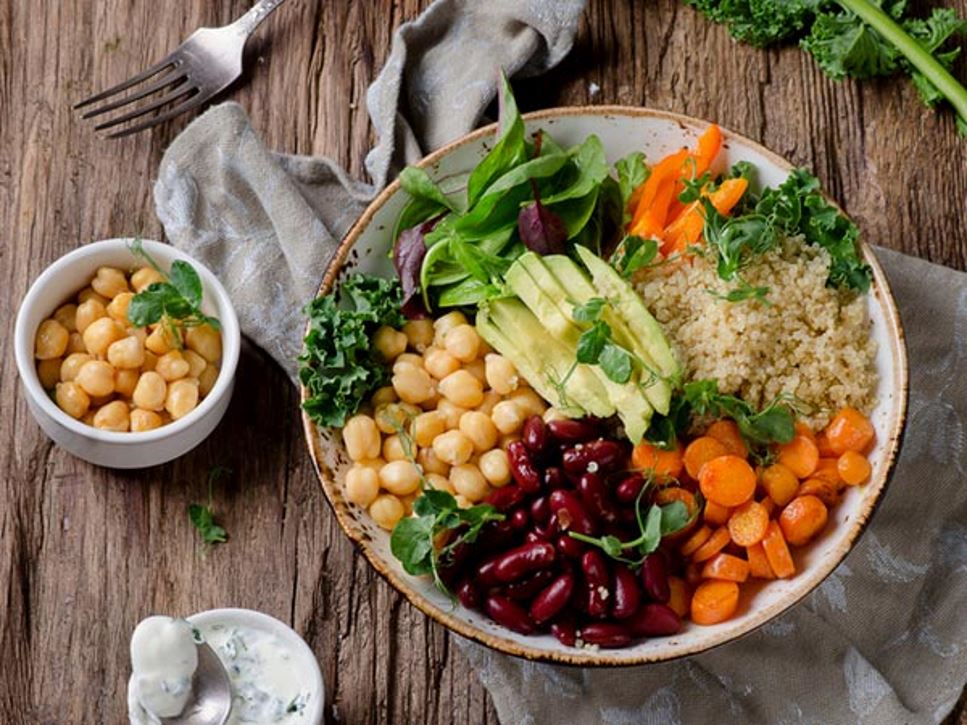You want to eat healthfully, but what's the best way to do it? Some of today's popular diets say to cut sugar while others restrict fat. With so many diet books and bloggers, it can be easy to become confused. But no matter the fad diet of the moment, choosing a balanced eating style that includes vegetables, fruits, whole grains, lean protein foods and dairy will provide you the nutrients and energy your body needs to help promote health.
A Healthy Eating Pattern
Rather than eating an exclusively fat-free or sugar-free diet, focus on your overall eating pattern. One meal does not make or break one's health; rather, it's what people do most of the time that has a significant impact. Choose vegetables, fruits, whole grains, beans, seafood, lean meats and nuts more often. Meanwhile, eat fewer processed meats, sugar-sweetened drinks, desserts and refined grains.
Vegetables and fruits should take up the most space on your plate (roughly half). Fill the remainder with whole grains and lean protein foods. While not every meal or snack requires each food group, pairing at least two or three different foods will increase your satisfaction and deliver more nutrients. And don't forget to pay attention to your body's hunger and fullness signals.
The Facts on Fat
The 2020-2025 Dietary Guidelines for Americans emphasize oils rich in monounsaturated and polyunsaturated fatty acids as part of a healthy eating pattern, and recommend limiting saturated and trans fats. Choosing the right kinds of fats, including those from fatty fish such as salmon, vegetable oils, nuts and seeds is especially important.
5 Tips for Making Good Decisions about Fat
- Include fatty fish, such as salmon, trout or mackerel once or twice per week. Baked, grilled and steamed version will be better for overall health than those that are fried.
- Vary your protein choices by eating more plant-based choices, such as soy foods, beans and lentils.
- Select lean cuts of meat and remove skin from poultry.
- Choose low-fat or fat-free dairy products or calcium-fortified soy versions rather than the full-fat version.
- Choose healthful sources of fat when cooking or assembling meals, such as nuts, seeds, avocado and olive or vegetable oils.
The Facts on Sugar
The 2020-2025 Dietary Guidelines for Americans recommend limiting added sugars to less than 10% of daily calories. Added sugars can be found in foods such as sugar-sweetened beverages and refined grain snacks and desserts. Naturally occurring sugars in foods such as fruit and milk are not added sugars.
3 Tips for Reducing Added Sugars
- Rethink sweets: Enjoy desserts in moderation.
- Instead of a post-dinner dessert, close out family mealtime with a cup of decaf coffee or herbal tea — but enjoy it without added sweeteners. Or, satisfy a post-meal sweet tooth with a piece of fruit.
- Switch from sweetened yogurt with added fruit to plain low-fat yogurt. Then, add fresh fruit for a nutritious, naturally sweet mid-morning snack. Fruit and low-fat dairy contain natural sugars that provide nutrients that promote health.
Your Personalized Healthy Eating Pattern
For more help developing a personalized healthy eating plan that includes appropriate amounts of fat and sugar, find a registered dietitian nutritionist in your area. Search the Academy's Find a Nutrition Expert directory.
Find a Nutrition Expert
Looking for credible nutrition information and recommendations? The Academy of Nutrition and Dietetics' network of credentialed food and nutrition practitioners are ready to help!

